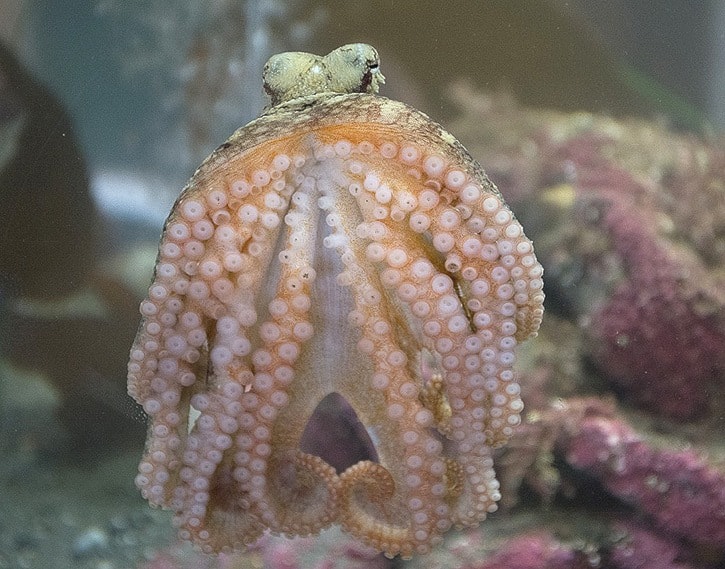A particularly playful Red Octopus is putting on quite the performance at the Ucluelet Aquarium.
Jeremiah arrived at the aquarium in August chalk full of moxy and quickly won the hearts of patrons.
“They think she’s really cute. They really like her,” said aquarium curator Laura Griffith-Cochrane.
“She’s very active during the day and she’s really good at manipulating her environment so she’s creating dens, she’s moving stuff around in the tank and she’s much more active in altering her environment.”
Griffith-Cochrane said Jeremiah grooved into her new environment faster than any other octopus the aquarium has welcomed this year.
“She’s been hanging out at the front, she’s been eating in front of visitors...she’s been doing really, really, well,” she said
Red Octopuses are small creatures that grow to roughly the size of an average person’s palm and reach a maximum weight of about 1 kilogram.
Griffith-Cochrane believes Jeremiah is about 1-year-old and said Red Octopuses only live for about two years.
Their diet consists mostly of crabs, which they eat by first paralyzing and then liquefying them.
“An octopus has two salivary glands. One of them releases that initial paralyzing chemical and the other one releases the liquefying chemical,” Griffith-Cochrane said.
“They drill through the back of the crab with their tongue, called a radula, liquefy the inside and suck it out like a milkshake.”
A Red Octopus will use its tongue like a slow moving drill to get through the crab’s shell.
“It goes through the very back of the carapace, which is the crab’s shell, and just creates a tiny little pinhole; it’s incredible small,” Griffith-Cochrane said.
“It uses a chemical that it produces to liquefy everything inside...It’s more of a waiting game. It’s kind of like when you’re putting everything into a blender and you’re making a smoothie; you wait until it’s all done and then you eat it.”
Red Octopuses live in shallow waters and make their homes in enclosed spaces, according to Griffith-Cochrane who said their love of tight spaces is often how they are caught.
“The ancient Greeks and Romans would make these clay pots and drop them in the ocean and octopuses like to be in enclosed small spaces so they would crawl inside and then these pots would be lifted up and they would catch octopuses that way and a lot of places still do catch octopuses that way,” she said.
She added the little animals can occasionally be found in discarded bottles.
“When Red Octopuses find beer bottles they have these nice predator free refuges...that’s often, when we’re doing beach cleanups, a concern we have. We have to have someone who watches anything that we bring up to make sure there’s nothing living inside,” she said noting an aquarium-hosted harbour cleanup a few years ago yielded a handful of the creatures.
“We put all of the beer bottles out on a big tarp and we had a volunteer checking every single one of them for Red Octopuses and we found six.”
While beer bottles are solid homes for this specific species, don’t get the idea that it’s cool to drop bottles in the ocean for them.
“There’s a lot of life that can get stuck in those so, while it works for one species, it can be pretty harmful for others,” Griffith-Cochrane said.
Red Octopuses mate in the same style as Giant Pacifics with the male using his hectocotylus arm to pass his sperm to the female.
“The end of the arm has a groove that it uses to give a spermatophore, which is a coiled rod of sperm, to the female and she stores that in her mantle where she fertilizes her eggs,” Griffith-Cochrane said.
“Once they lay their eggs they stop eating. It takes so much out of them to lay all of these eggs that all they really have energy for at the end is to push water across the eggs, clean them, make sure that they’re free of bacterial growths and algae and that they’re getting lots of oxygen and then, after caring for them for a couple of months, their body just breaks down and they die.”
Griffith-Cochrane noted that when Jeremiah first arrived at the aquarium, staff weren’t quite sure what they were looking at.
“The way that you tell the difference between a Giant Pacific Octopus and a Red Octopus are three small folds below the eyes, they look almost like eyelashes,” she said.
“It can be really hard to see those sometimes, especially because we want anything that we bring in to relax as quickly as possible. We want to reduce stress so we try to get them into a place where they can really relax, get under rocks, find a little den, make a home for themselves, and then, when they come out on their own time, we try to identify them.
“Now that this one is coming out and is feeling very comfortable, we can see those three folds so we know it’s a Red Octopus but at the beginning we weren’t sure and we didn’t want to prod it to figure out.”
andrew.bailey@westerlynews.ca
